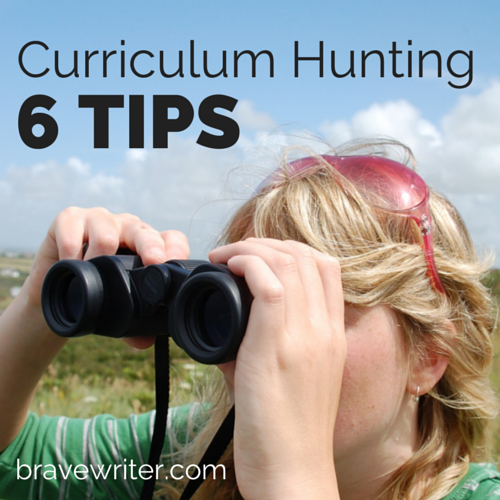For the early birds!
The early-birds are busy curriculum shopping for next year while the exhausted are saving that work for July!
Here are my tips for curriculum hunting:
1. If the curriculum is new to you, don’t buy a year’s worth all at once (unless it’s your usual math text book). See if you can borrow someone else’s for a month or purchase one level or one aspect of the program and test it. The worst thing you can do is make a big non-refundable year long investment in an untested product, only to feel obligated to slog through it (dragging unhappy kids along) all 10 months because you “spent so much money.”
2. Talk to your kids about your curriculum shopping. Get them involved. Bring them to the computer, read them descriptions, show them what the products look like. Kids have strong opinions about colors, fonts, paper textures, how the app works, what the philosophy is. You don’t want those strong opinions slapping you upside the head on the first day of school! And remember: they are the ones using it. So even if it totally appeals to you, that doesn’t mean it’s right for your child.
3. Purchase cool STUFF not just cool books. Kids love microscopes, binoculars, digital camcorders, digital hand held audio recorders, iPads, tablets, sewing machines, knitting needles, garden tools, watercolors, oils, an easel, sculpting clay, dress up clothes, pocket knives, sleds, bird feeders, tambourines, hammers, saws, shovels, walking sticks, beads, hand mixers, baking tins, finger puppets, globes, tea sets, canteens, umbrellas, graphing calculators, a compass, rulers, puzzles, blocks, new Lego sets, dominoes, recorders, bells and whistles, clipboards, new journals, new pens (try fountain!), music, and movies … You get the idea.
4. Understand the philosophy of the product, not just its goals or promises. Just because a product says it teaches a comprehensive view of American history doesn’t mean that the view it teaches is a fair-minded one. Just because a product says it teaches manipulative-based phonics to 6 year olds doesn’t mean it’s the right philosophy for your 6 year old. The philosophy needs to match your child’s aptitudes as well as your style of implementation. If you’re a “follow the inspiration” parent, a highly structured program will not likely be successful for you. And vice versa.
5. Understand your own philosophy of home education. You want to carry the thread all the way through your subject areas. It doesn’t work to go from one system to another, subject-to-subject. Make a list of your bottom lines (what you must have to feel successful at home with your kids). Then compare those to the curriculum choices you make. Don’t chase the “shiny new” just because it is shiny and new. Create a rhythm for your family that matches how you all actually live, not how you imagine you should be living.
6. It’s okay not to have all your books and decisions made before the year starts. In fact, experiment with feathering in subjects over the course of the first few months. Try using one product for a little while, then add a subject and another product. This is the key to success. Trying to do everything, all at once, from the first day, understanding all the practices, ideas, strategies, and plans can be exhausting and stressful to all.
Feel free to only do language arts for the first two weeks, to finish before lunch, to play all afternoon. You can add math, once LA is under control and everyone feels good. You can add history a few weeks later, once those two are humming along. This gives you time to select products, too, once you see what’s realistic for your family. That big DVD program might appeal in July, but by October, you see that your life is already really full and a simple math book is easier for you to manage. So give yourself room and space to think about what you use next year while the year is going, if that helps you.
What tips do you have? I’d love to hear them.
Image by Andy Wright (cc cropped, text added)



















I got a bit of chuckle out of your opening line on this one. “The early-birds are busy curriculum shopping for next year…” Honey, the early-birds aren’t busy shopping for next year, we’ve already made our decisions, bought our materials, and are busy organizing them for next year. Of course, we start our school year in July so shopping then is rather out of the question.
Thank you for this wonderful reminder, very timely for convention season. I’m pinning it for others to see.
I think you hit on a key with giving the kids some say in what you choose to cover a topic with! The older they are the more I become counselor and they choose the curricula.
Another key at my house is using multi-level products that I can fold all my kids into (or all but the oldest). I’m mother to soon to be eight children who will be 7th grade down to newborn this fall. My 3rd and under crowd will be working together in most subjects (history, science, health, etc). The 7th grader will be in the same time period but using books on her level, and is doing General Science this year. I’m using the table of contents for her science book to plan topics each month for the younger kids so they’re doing similar things on their own level. 🙂